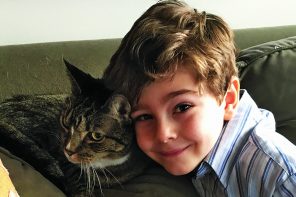Michael Bruno — the self-styled “serial entrepreneur” behind 1stdibs, Tuxedo Hudson Co., Housepad App and Art-Design-Carta — collects animals, as objects.
“I have all these animals all over the place in our house,” said the Larchmont native of his Tuxedo Park home.
Dee Ocleppo Hilfiger — co-owner, creative director and global ambassador of Judith Leiber and wife of Tommy — collects vintage clothes. (And added that the ’80s are back so get out your shoulder pads.)
Veronica Swanson Beard — who with her sister-in-law Veronica Miele Beard is the designer and co-founder of, yes, the Veronica Beard fashion brand — is a self-confessed “hoarder with a very extensive collection of small vases for all my flowers. I can’t buy enough.”
For Rachel Vaisman — senior director at The RealReal luxury consignment website — collecting is all about “small dinosaurs and Disney princesses.” (She has three children under the age of 5.)
That brought back memories for new media entrepreneur Lesley Jane Seymour, founder of coveyclub.com: “My kids had 1,000 beheaded Barbies. I feel your pain.”
All joking aside, the witty panelists for the Bruce Museum’s fourth annual “Art of Design” fundraiser, held March 2 at Greenwich County Club, along with moderator Seymour, shed light on a variety of personal collections, inspirations and experiences. But one thing they all agreed on was the 800-pound digital gorilla in the room. (Indeed the panel might’ve been called the “Art of the Web.”) Today, it’s all about the net and, particularly, Instagram, the photo-sharing app whose growth has outpaced that of its parent company, Facebook.
“I’m fascinated by Instagram,” said Hilfiger, who’ll be redoing the Judith Leiber website. “I’m focusing on the new techniques, because everything’s moving so quickly that you have to try if not get ahead then at least stay with (technology).
“Apple inspires me a lot. Steve Jobs made the computer sexy. He convinced everyone that they needed a laptop and a cell phone.”
Such sexiness has translated, of course, into eyeballs and dollars. For the last Tommy Hilfiger show, Dee said, they used It Girl Gigi Hadid — who has 26 million Instagram followers — as the main model. That’s worth more than all the advertising in the fashion magazines combined, she added.
Such thoughts are a stab to the heart of Seymour, the onetime editor-in-chief of virtually every women’s magazine (More, Marie Claire, Redbook and YM). She was also beauty director of Glamour and senior editor at Vogue.
“It’s heartbreaking but the sad truth is print is too expensive,” she said. “It’s all about advertising. Once the advertisers realized they no longer had to go through the door and kiss the butts of editors, they abandoned ship.”
But the digital relationship to the modern world is a complex one. We live in a visual culture but not necessarily a visually literate one that can “read” the paintings that make up the ravishing Alfred Sisley exhibit at the Bruce, for instance. There is a vast deal of difference between seeing an artwork online and discovering it in an art catalog or in the flesh — murmured some of the 200 attendees. (Peter C. Sutton, the Bruce’s Susan E. Lynch executive director, described the audience as a “voluble group.”)
Then, too, in an age that is all about “telling it like it is,” reality TV and the search for the authentic — about half the audience raised their hands when asked if they’d rather have an experience instead of stuff — the internet offers only a virtual experience.
“Women want to go to a store and they want to touch the product,” says Veronica S. Beard, whose Veronica Beard brand exists as a brick-and-mortar Madison Avenue shop as well as an online business.
“And we get to see them come in,” said Veronica M. Beard, who collects “wacko world trips.” “We want to know all about them,” Veronica S. added.
That need for a personal relationship may be one reason that Bruno said: “There’s a lot of luxury online but it’s not making money. Venture capitalists aren’t interested, and raising money is difficult. You have to spend a lot of money to get customers.” He pointed to Nasty Gal, the millennially-minded e-commerce site that filed for bankruptcy in November while it restructures.
The RealReal is, however, an example of luxury online that is working. But then, the self-styled “largest authenticated consignment website” has 50 managers picking up more than 40,000 luxe items each month from private consignors. The personal touch is important.
So while Bruno has the trade-exclusive site Art-Design-Carta, he’s also creating The Gateway to The Hudson Valley, a project along the Route 17 Corridor between Sloatsburg and Tuxedo that includes two boutique hotels devoted to cycling and hiking respectively and eateries in which students from The Culinary Institute of America will work alongside Tuxedo Hudson Co. chefs.
Said Bruno: “It’s all about creating an experience.”





